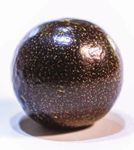NEW NATIONAL PASSIONFRUIT BREEDING PROGRAM (PF19000) - Passionfruit Australia
←
→
Page content transcription
If your browser does not render page correctly, please read the page content below
NEW NATIONAL PASSIONFRUIT
BREEDING PROGRAM (PF19000)
BY DR CATHERINE NOCK, SCU
THE NEXT PHASE
PROJECT OVERVIEW more frequent blind-tipping and also where possible, across the three main
problems with finding suitable tips for growing regions of Northern New South
The next phase of the grafting due to thinner tips. Wales/South East Queensland, Wide Bay
National Passionfruit Breeding region and North Queensland.
The new project will continue and expand
and Evaluation Program has been on the first phase of the breeding program — P
erformance data collected for advanced
recently contracted to continue building on the expertise and resources material for grower information.
breeding research to deliver new developed over the past four years. — P
roduction of partially inbred selections
varieties for Australian growers. The project will concentrate mainly on
with the aim of producing a purple Panama.
The program has been led by scion variety breeding and aims to produce, — M
aintain arboretum and expand the seed
select and evaluate new high yielding scion bank to preserve important germplasm.
Dr Peter Bundock and a research
varieties for Australian passionfruit growers.
team at Southern Cross University Some initial work aimed at producing a
— E
stablish a Breeding Management
since 2016. System for data acquisition, long-term
new Panama line will also be commenced.
storage and analysis.
The new 5-year project is As part of this new phase, the project will
— P
hD student project with scholarship
funded by Hort Innovation using continue to engage with growers through provided by Southern Cross University:
the passionfruit research and field walks, presentations, industry news
articles, and will seek input from a project — D
etermine which parent scion
development levy, and funds from varieties produce the best progeny
reference group of growers to steer
the Australian Government, and priorities towards grower needs. by estimating breeding values based
supported by contributions from on important traits. These best
Southern Cross University. parents then used to produce
BROAD OBJECTIVES
larger numbers of progeny for
As most of you will know, the main scion — F
ield trialling program designed to the selection of a future variety.
varieties of passionfruit grown in Australia select the best performing varieties
— S
tudy of genetic variation for
– Sweetheart and Misty Gem - have been for growers. Early-stage trial vines
fruit shelf life.
propagated by tip cuttings for some years (1st and 2nd stage – see Breeding Cycle
and a number of problems have been for selecting scion varieties) will be
reported including reduced fruit size and evaluated primarily at Alstonville,
with advanced selections trialled,
yield compared to the original selections,
1 2
Figure 1. Dr Peter Bundock and Dr Catherine Nock at the Figure 2. One of the promising 2nd stage selections from the breeding program
Centre for Tropical Horticulture Alstonville trial site.
14 www.passionfruitaustralia.org.auBREEDING CYCLE FOR
SELECTING SCION VARIETIES
Novel germplasm
Elite germplasm — these have
been evaluated as the best parents
Test new (highest breeding value) from
selections a founding group
as parents
CROSSES
PHENOTYPING:
Traits in breeding goal
measured in subset of
stage 1 progeny.
STAGE 1: Grafted seedlings from
crosses, grown and assessed at
a single site — one season
SELECTION ONE:
Field assessment sheet for
STAGE 2: 1 season, discarding 95%
multiple clones,
2+ local sites
SELECTION TWO:
Index scores and
STAGE 3: fruit quality parameters
2 seasons,
# VINES/ 3 regions
SELECTION # LOCATIONS
SELECTION THREE:
Measure traits in breeding
ADVANCED
SELECTIONS goal at home site. Index
scores elsewhere.
Traits in breeding goal: e.g. estimated yield of first grade
fruit, fruit disease impact, weight/fruit size, pulp pH, etc.
Field assessment sheet: Scored as Acceptable or Not;
vine health, shell colour, fruit size, pulp fullness, flavour,
shell thickness, disease free, blemish free, productivity.
Index score: All traits scored in the field — visual vine and
in the fruit quality. Measured from 0—9.
Fruit quality parameters: Colour, weight, size, total
acidity, pH, sweetness (BRIX)
THE PASSION VINE | SUMMER 2020 15PROJECT TEAM research, data and project management, RECENT PROJECT UPDATE
and germplasm conservation.
The ongoing research team includes
(NOVEMBER 2020)
Dr Peter Bundock, Associate Professor She has successfully led Hort Innovation
Over the past month 300 first stage
Tobias Kretzschmar, Frances Eliott and macadamia research projects and is a
seedlings have been planted mostly
Will Petrie. Management of the project collaborator on the Australian macadamia
at the Centre for Tropical Horticulture
will be transferred to Dr Cathy Nock in breeding program.
trial site at Alstonville.
mid-2021 following an extended transition Together, the Southern Cross University
These are from cross pollinations of
period to ensure the security of project team has knowledge of the current
select parents that were carried out
data, background information, germplasm passionfruit breeding methods and industry
by the team last summer.
and technical expertise. requirements along with a commitment
to applying new methods to create new The Alstonville trial site also contains
Cathy is a research fellow at Southern Cross
opportunities for producing passionfruit replicates of promising 2nd stage
University. She has lived in the Northern
varieties into the future. Cathy is looking selections and an arboretum with
Rivers of NSW for over 25 years and her
forward to meeting growers over the diverse germplasm.
main research interest is subtropical
horticulture. Cathy is a geneticist with coming months and to working with
expertise in pre-breeding and breeding the passionfruit industry.
3
4a 4b
Figure 3. Fruit from one of the promising 2nd stage selections from the breeding program
Figure 4. Alstonville trial site and arboretum (a) September 2020 (b) November 2020, planting new grafted 1st stage seedlings and 2nd stage selections.
16 www.passionfruitaustralia.org.auYou can also read























































